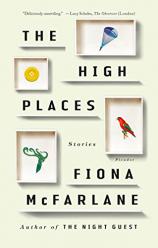The High Places: Stories
Review
The High Places: Stories
Fiona McFarlane’s THE HIGH PLACES, a time-bending collection of short stories about modern Australian life, is nothing short of a triumph. I say “time-bending” because it is the best phrase I have to describe McFarlane’s narrative style, though it doesn’t even come close to doing her work justice. She manages to make the reader feel comfortable in whatever setting she has dropped them into, despite rarely dwelling upon period details. She accomplishes this feat through tantalizing the audience with smidgeons of context that she embeds within sweeping landscape paintings of paragraphs, all the while plunging ever deeper into her characters’ headspaces. Her technique is oh-so-subtle and so deliciously rich. It calls to mind Julio Cortázar’s BLOW-UP: And Other Stories, most particularly “The Night Face Up” and “Continuity of Parks.”
"Despite McFarlane’s characters having a thorough understanding of history, or at least tradition, they are still doomed to repeat the past. These types of thought-provoking twists make McFarlane’s writing such a treat to read."
Although THE HIGH PLACES was published in 2016, McFarlane’s stories are not contemporary. This collection is preoccupied with characters whose motives are rooted, or dare I say trapped, in the past. While this theme is prevalent throughout the book, nowhere is it more in-your-face than my personal favorite story, “The Movie People.” It takes place in an unnamed part of Australia that we are to assume is somewhat rural or, at the very least, quaint, because it opens right as the filming of a period piece in the town comes to an end. Yet, unlike the filmmakers, who can slip out as if nothing ever happened, the town is unable to get over its movie madness. Its inhabitants begin to live as if their reality is the movie in which they were extras.
The plot is wonderfully surreal and emotionally charged. The reader wants to sympathize with the narrator, who seems to be the only person in town who hasn’t gone insane. He is determined to win back his wife, Alice, who is so corrupted by the movie people that she nearly marries the star’s stand-in. However, as the story draws on, we begin to wonder if the narrator is in the wrong after all. Why else would he feel the need to exert such control over Alice and the rest of the townspeople when they are, in fact, happy?
Janet Dwyer, a middle-aged high school teacher from Sydney, ponders a similar question during a flashback in my second-favorite story, “Mycenae.” It is set in, as you would imagine, Greece, where the frumpy but lovable Janet and Murray Dwyer go on vacation for a week with their long-lost American friends, Eric and Amy Anderson. The trip, of course, does not go perfectly, and Janet is plagued with typical touristy insecurities. She spends much of her time worrying about what the Andersons must think of her and Murray, and even though she knows it’s pointless, she constantly compares herself to the thin, confident Amy.
This proves to be a mistake as Amy reveals that her life is not as perfect as it appears. She uses Janet as cover for a one-afternoon stand with a younger Athenian, which reminds Janet of Amy’s infidelities when the two couples met 40 years ago in England. Everything comes to a head when tall, impassive Eric faints from heatstroke in Mycenae, the ancient home of kings, the one destination Janet picks for the group.
“Those who cannot remember the past are condemned to repeat it.” George Santayana’s adage rules the stories of THE HIGH PLACES. Despite McFarlane’s characters having a thorough understanding of history, or at least tradition, they are still doomed to repeat the past. These types of thought-provoking twists make McFarlane’s writing such a treat to read.
Reviewed by Alex Bowditch on June 3, 2016
The High Places: Stories
- Publication Date: May 9, 2017
- Genres: Fiction, Short Stories
- Paperback: 288 pages
- Publisher: Picador
- ISBN-10: 1250131855
- ISBN-13: 9781250131850





